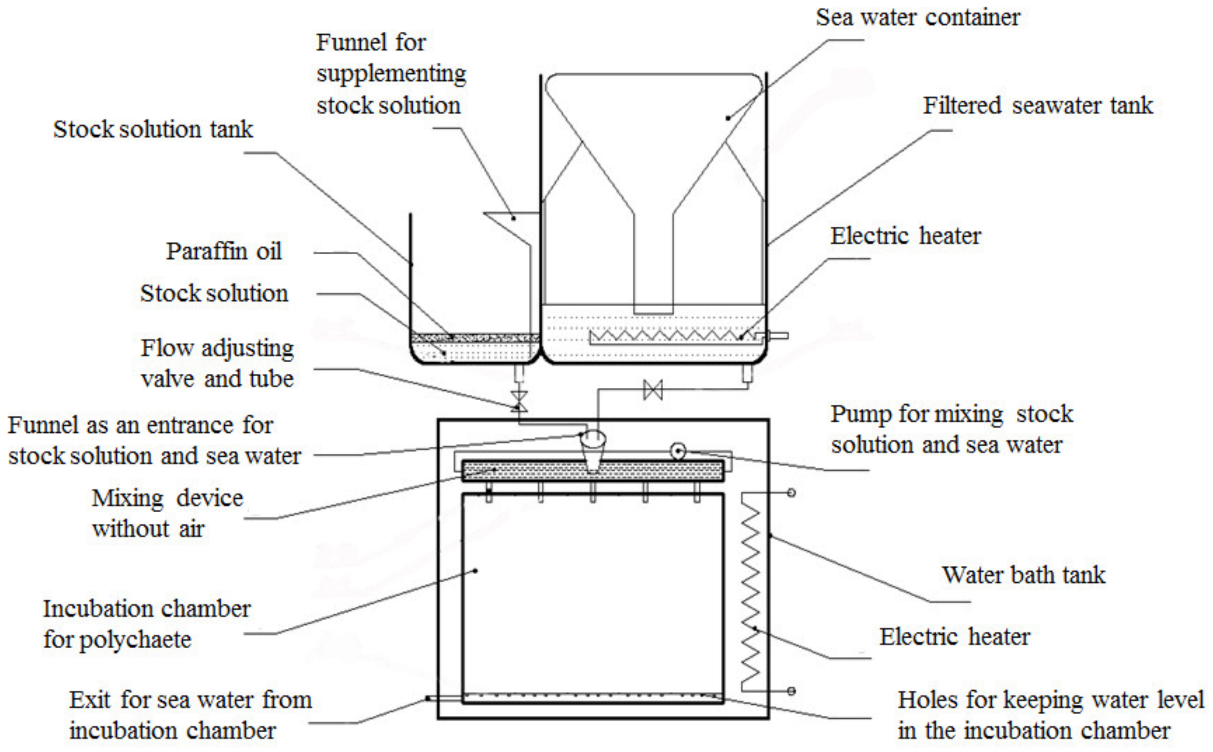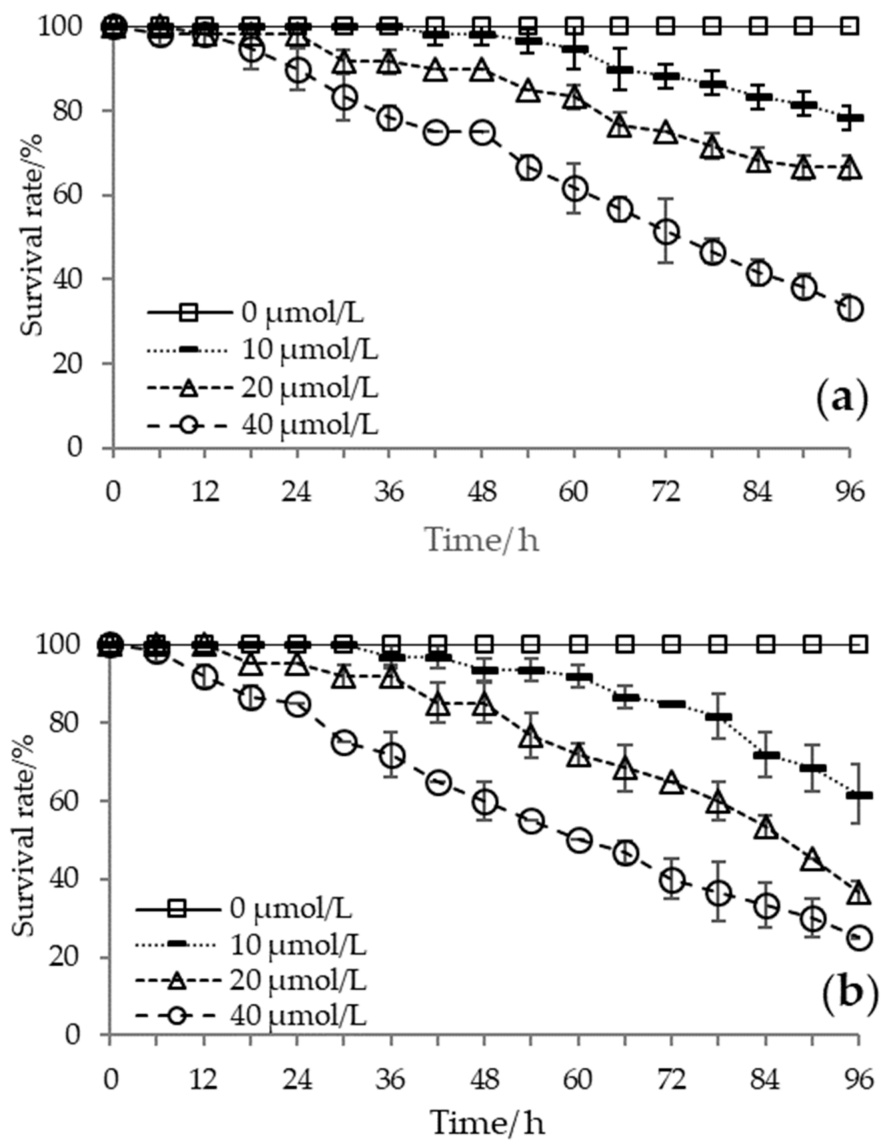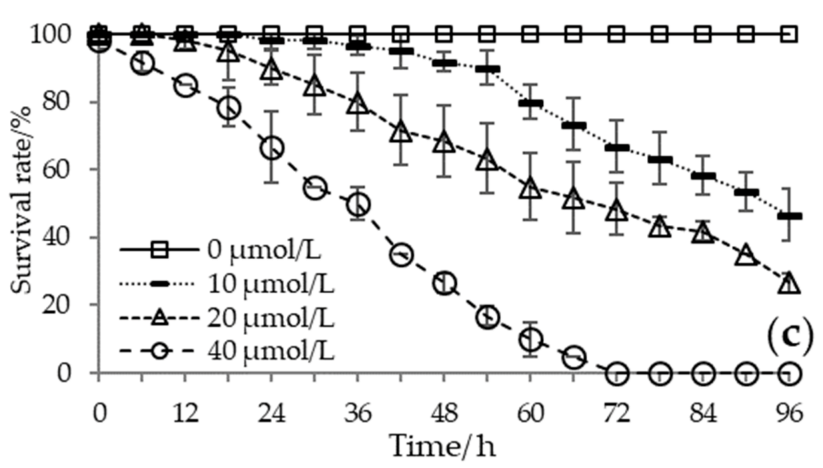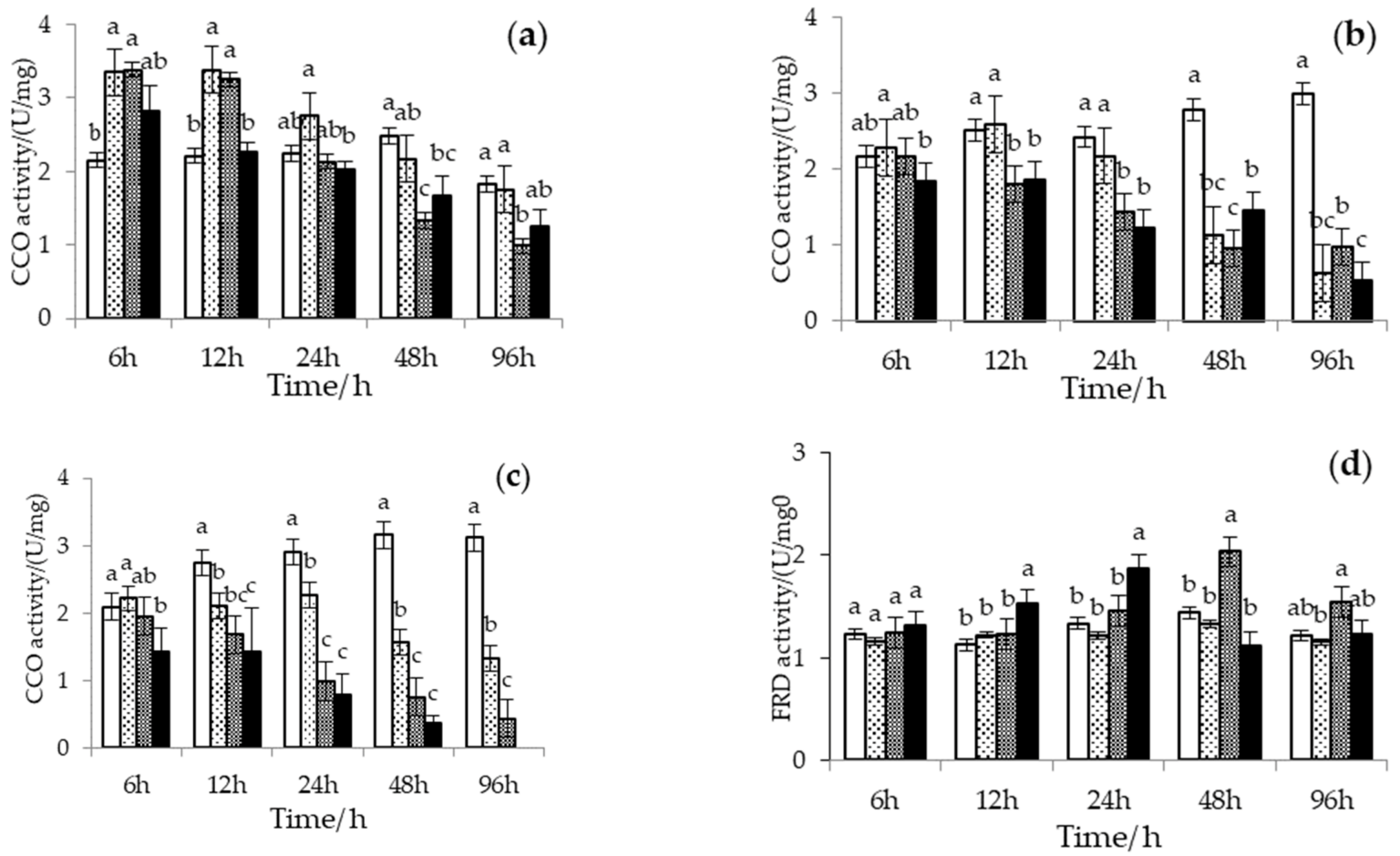Defense System of the Manila Clam Ruditapes philippinarum under High-Temperature and Hydrogen Sulfide Conditions
Abstract
Simple Summary
Abstract
1. Introduction
2. Materials and Methods
2.1. The Experimental Animal
2.2. The Experimental Device
2.3. The Experimental Design
2.4. Monitoring Index Analyses
2.5. Statistical Analyses
3. Results
3.1. Survival and Behavioral Responses
3.2. Physiological Responses
3.3. Cellular Structure Damage
4. Discussion
4.1. Behavioral Defense to H2S Stress
4.2. Chemical Defense to H2S Stress
4.3. Organ Specificity in H2S Damages
4.4. Synergistic Effect of High Temperature and H2S
5. Conclusions
Author Contributions
Funding
Institutional Review Board Statement
Informed Consent Statement
Data Availability Statement
Acknowledgments
Conflicts of Interest
References
- Dachs, J.; Méjanelle, L. Organic Pollutants in Coastal Waters, Sediments, and Biota: A Relevant Driver for Ecosystems during the Anthropocene? Estuaries Coasts 2010, 33, 1–14. [Google Scholar] [CrossRef]
- Matozzo, V.; Binelli, A.; Parolini, M.; Previato, M.; Masiero, L.; Finos, L.; Bressan, M.; Marin, M.G. Biomarker Responses in the Clam Ruditapes Philippinarum and Contamination Levels in Sediments from Seaward and Landward Sites in the Lagoon of Venice. Ecol. Indic. 2012, 19, 191–205. [Google Scholar] [CrossRef]
- Diaz, R.J.; Rosenberg, R. Spreading Dead Zones and Consequences for Marine Ecosystems. Science 2008, 321, 926–929. [Google Scholar] [CrossRef] [PubMed]
- Metzger, E.; Langlet, D.; Viollier, E.; Koron, N.; Riedel, B.; Stachowitsch, M.; Faganeli, J.; Tharaud, M.; Geslin, E.; Jorissen, F. Artificially Induced Migration of Redox Layers in a Coastal Sediment from the Northern Adriatic. Biogeosciences 2014, 11, 2211–2224. [Google Scholar] [CrossRef]
- Kodama, K.; Waku, M.; Sone, R.; Miyawaki, D.; Ishida, T.; Akatsuka, T.; Horiguchi, T. Ontogenetic and Temperature-Dependent Changes in Tolerance to Hypoxia and Hydrogen Sulfide during the Early Life Stages of the Manila Clam Ruditapes Philippinarum. Mar. Environ. Res. 2018, 137, 177–187. [Google Scholar] [CrossRef]
- Breitburg, D.; Levin, L.A.; Oschlies, A.; Grégoire, M.; Chavez, F.P.; Conley, D.J.; Garçon, V.; Gilbert, D.; Gutiérrez, D.; Isensee, K.; et al. Declining Oxygen in the Global Ocean and Coastal Waters. Science 2018, 359, eaam7240. [Google Scholar] [CrossRef]
- Sakai, S.; Nakaya, M.; Sampei, Y.; Dettman, D.L.; Takayasu, K. Hydrogen Sulfide and Organic Carbon at the Sediment–Water Interface in Coastal Brackish Lake Nakaumi, SW Japan. Environ. Earth Sci. 2013, 68, 1999–2006. [Google Scholar] [CrossRef]
- Bagarinao, T. Sulfide as an Environmental Factor and Toxicant: Tolerance and Adaptations in Aquatic Organisms. Aquat. Toxicol. 1992, 24, 21–62. [Google Scholar] [CrossRef]
- Hance, J.M.; Andrzejewski, J.E.; Predmore, B.L.; Dunlap, K.J.; Misiak, K.L.; Julian, D. Cytotoxicity from Sulfide Exposure in a Sulfide-Tolerant Marine Invertebrate. J. Exp. Mar. Biol. Ecol. 2008, 359, 102–109. [Google Scholar] [CrossRef]
- Joyner-Matos, J.; Predmore, B.L.; Stein, J.R.; Leeuwenburgh, C.; Julian, D. Hydrogen Sulfide Induces Oxidative Damage to RNA and DNA in a Sulfide-Tolerant Marine Invertebrate. Physiol. Biochem. Zool. 2010, 83, 356–365. [Google Scholar] [CrossRef]
- Nagasoe, S.; Yurimoto, T.; Suzuki, K.; Maeno, Y.; Kimoto, K. Effects of Hydrogen Sulfide on the Feeding Activity of Manila Clam Ruditapes Philippinarum. Aquat. Biol. 2011, 13, 293–302. [Google Scholar] [CrossRef]
- Smith, L.; Kruszyna, H.; Smith, R.P. The Effect of Methemoglogin on the Inhibition of Cytochrome c Oxidase by Cyanide, Sulfide or Azide. Biochem. Pharmacol. 1977, 26, 2247–2250. [Google Scholar] [CrossRef]
- Vismann, B. Sulfide Species and Total Sulfide Toxicity in the Shrimp Crangon Crangon. J. Exp. Mar. Biol. Ecol. 1996, 204, 141–154. [Google Scholar] [CrossRef]
- Kump, L.R.; Pavlov, A.; Arthur, M.A. Massive Release of Hydrogen Sulfide to the Surface Ocean and Atmosphere during Intervals of Oceanic Anoxia. Geology 2005, 33, 397. [Google Scholar] [CrossRef]
- Hasler-Sheetal, H.; Holmer, M. Sulfide Intrusion and Detoxification in the Seagrass Zostera Marina. PLoS ONE 2015, 10, e0129136. [Google Scholar] [CrossRef]
- Hahlbeck, E.; Arndt, C.; Schiedek, D. Sulphide Detoxification in Hediste Diversicolor and Marenzelleria Viridis, Two Dominant Polychaete Worms within the Shallow Coastal Waters of the Southern Baltic Sea. Comp. Biochem. Physiol. B Biochem. Mol. Biol. 2000, 125, 457–471. [Google Scholar] [CrossRef] [PubMed]
- Zhang, Z. Adaptation of Respiratory Metabolism to Sulfide Exposure in Urechis Unicinctus. Period. Ocean Univ. China 2006, 36, 639–644. [Google Scholar] [CrossRef]
- Wang, H.; Wang, G.; Fang, J.; Jiang, Z.; Du, M.; Gao, Y.; Fang, J. Acute Sulphide Toxicity in Perinereis Aibuhitensis under Different Salinities and Temperatures: LC50 and Antioxidant Responses. Aquat. Biol. 2017, 26, 75–85. [Google Scholar] [CrossRef]
- Qiu, J.; Ma, F.; Fan, H.; Li, A. Effects of Feeding Alexandrium Tamarense, a Paralytic Shellfish Toxin Producer, on Antioxidant Enzymes in Scallops (Patinopecten Yessoensis) and Mussels (Mytilus Galloprovincialis). Aquaculture 2013, 396–399, 76–81. [Google Scholar] [CrossRef]
- Vidal-Liñán, L.; Bellas, J.; Campillo, J.A.; Beiras, R. Integrated Use of Antioxidant Enzymes in Mussels, Mytilus Galloprovincialis, for Monitoring Pollution in Highly Productive Coastal Areas of Galicia (NW Spain). Chemosphere 2010, 78, 265–272. [Google Scholar] [CrossRef]
- Carvalho, S.; Barata, M.; Gaspar, M.B.; Pousão-Ferreira, P.; Cancela da Fonseca, L. Enrichment of Aquaculture Earthen Ponds with Hediste Diversicolor: Consequences for Benthic Dynamics and Natural Productivity. Aquaculture 2007, 262, 227–236. [Google Scholar] [CrossRef]
- Liu, Y.; Zhang, J.; Wang, X.; Wu, W.; Kang, Q.; Li, C. Temperature-Induced Environmental Chain Reaction in Marine Sedimentation and Its Impact on Manila Clam Ruditapes Philippinarum. Front. Mar. Sci. 2022, 9, 845768. [Google Scholar] [CrossRef]
- Vaquer-Sunyer, R.; Duarte, C.M. Sulfide Exposure Accelerates Hypoxia-Driven Mortalit. Limnol. Oceanogr. 2010, 55, 1075–1082. [Google Scholar] [CrossRef]
- Gamain, P.; Roméro-Ramirez, A.; Gonzalez, P.; Mazzella, N.; Gourves, P.-Y.; Compan, C.; Morin, B.; Cachot, J. Assessment of Swimming Behavior of the Pacific Oyster D-Larvae (Crassostrea Gigas) Following Exposure to Model Pollutants. Environ. Sci. Pollut. Res. 2020, 27, 3675–3685. [Google Scholar] [CrossRef] [PubMed]
- El-Shenawy, N.S. Heavy-Metal and Microbial Depuration of the ClamRuditapes Decussatus and Its Effect on Bivalve Behavior and Physiology. Environ. Toxicol. 2004, 19, 143–153. [Google Scholar] [CrossRef] [PubMed]
- Affonso, E.G.; Polez, V.L.P.; Corrêa, C.F.; Mazon, A.F.; Araújo, M.R.R.; Moraes, G.; Rantin, F.T. Physiological Responses to Sulfide Toxicity by the Air-Breathing Catfish, Hoplosternum Littorale (Siluriformes, Callichthyidae). Comp. Biochem. Physiol. Part C Toxicol. Pharmacol. 2004, 139, 251–257. [Google Scholar] [CrossRef]
- Xiao, S.H.; Feng, J.J.; Guo, H.F.; Jiao, P.Y.; Yao, M.Y.; Jiao, W. Effects of Mebendazole, Albendazole, and Praziquantel on Succinate Dehydrogenase, Fumarate Reductase, and Malate Dehydrogenase in Echinococcus Granulosus Cysts Harbored in Mice. Zhongguo Yao Li Xue Bao 1993, 14, 151–154. [Google Scholar] [PubMed]
- Lee, A.-C.; Lee, Y.-C.; Chin, T.-S. Effects of Low Dissolved Oxygen on the Digging Behaviour and Metabolism of the Hard Clam (Meretrix Lusoria): Digging Behavior and Metabolism of Hard Clams. Aquac. Res. 2012, 43, 1–13. [Google Scholar] [CrossRef]
- Long, W.C.; Brylawski, B.J.; Seitz, R.D. Behavioral Effects of Low Dissolved Oxygen on the Bivalve Macoma Balthica. J. Exp. Mar. Biol. Ecol. 2008, 359, 34–39. [Google Scholar] [CrossRef]
- Markich, S. Valve Movement Responses of Velesunio Angasi (Bivalvia: Hyriidae) to Manganese and Uranium: An Exception to the Free Ion Activity Model. Aquat. Toxicol. 2000, 51, 155–175. [Google Scholar] [CrossRef]
- O’Brien, J.; Vetter, R.D. Production of Thiosulphate during Sulphide Oxidation by Mitochondria of the Symbiont-Containing Bivalve Solemya Reidi. J. Exp. Biol. 1990, 149, 133–148. [Google Scholar] [CrossRef] [PubMed]
- Guan, Y. Effects of Sulphide on the Enzyme of Respiratory Metabolism and Energy Metabolism of Macrobrachium Nipponense. Ecol. Environ. Sci. 2009, 18, 2017–2022. [Google Scholar] [CrossRef]
- Li, Q.; Sun, S.; Zhang, F.; Wang, M.; Li, M. Effects of Hypoxia on Survival, Behavior, Metabolism and Cellular Damage of Manila Clam (Ruditapes Philippinarum). PLoS ONE 2019, 14, e0215158. [Google Scholar] [CrossRef] [PubMed]
- Wang, F.; Chapman, P.M. Biological Implications of Sulfide in Sediment-a Review Focusing on Sediment Toxicity. Environ. Toxicol. Chem. 1999, 18, 2526–2532. [Google Scholar] [CrossRef]
- Xu, X.H.; Zhang, Y.Q.; Yan, B.L.; Xu, J.T.; Tang, Y.; Du, D.D. Immunological and Histological Responses to Sulfide in the Crab Charybdis Japonica. Aquat. Toxicol. 2014, 150, 144–150. [Google Scholar] [CrossRef]
- Sun, Z.; Wang, L.; Zhang, T.; Zhou, Z.; Jiang, Q.; Yi, Q.; Yang, C.; Qiu, L.; Song, L. The Immunomodulation of Inducible Hydrogen Sulfide in Pacific Oyster Crassostrea Gigas. Dev. Comp. Immunol. 2014, 46, 530–536. [Google Scholar] [CrossRef] [PubMed]
- Howard, A.C.; Poirrier, M.A.; Caputo, C.E. Exposure of Rangia Clams to Hypoxia Enhances Blue Crab Predation. J. Exp. Mar. Biol. Ecol. 2017, 489, 32–35. [Google Scholar] [CrossRef]
- Kim, T.W.; Park, S.; Sin, E. At the Tipping Point: Differential Influences of Warming and Deoxygenation on the Survival, Emergence, and Respiration of Cosmopolitan Clams. Ecol. Evol. 2018, 8, 4860–4866. [Google Scholar] [CrossRef]









| Criterion | Score |
|---|---|
| The shell is entirely closed or slightly open, but the mantle is not clear | 0 |
| The shell is open, and the mantle is visible | 1 |
| The shell is open, and the siphon is protruding, but the protrusion length is short | 2 |
| The shell is open, and the siphon extends more than 1/3 of its full length | 3 |
| The shell opens, and the siphon and foot are extended | 4 |
Disclaimer/Publisher’s Note: The statements, opinions and data contained in all publications are solely those of the individual author(s) and contributor(s) and not of MDPI and/or the editor(s). MDPI and/or the editor(s) disclaim responsibility for any injury to people or property resulting from any ideas, methods, instructions or products referred to in the content. |
© 2023 by the authors. Licensee MDPI, Basel, Switzerland. This article is an open access article distributed under the terms and conditions of the Creative Commons Attribution (CC BY) license (https://creativecommons.org/licenses/by/4.0/).
Share and Cite
Liu, Y.; Wang, X.; Du, Y.; Zhong, Y.; Wu, W.; Yang, J.; Zhang, J. Defense System of the Manila Clam Ruditapes philippinarum under High-Temperature and Hydrogen Sulfide Conditions. Biology 2023, 12, 278. https://doi.org/10.3390/biology12020278
Liu Y, Wang X, Du Y, Zhong Y, Wu W, Yang J, Zhang J. Defense System of the Manila Clam Ruditapes philippinarum under High-Temperature and Hydrogen Sulfide Conditions. Biology. 2023; 12(2):278. https://doi.org/10.3390/biology12020278
Chicago/Turabian StyleLiu, Yi, Xinmeng Wang, Yanqiu Du, Yi Zhong, Wenguang Wu, Jun Yang, and Jihong Zhang. 2023. "Defense System of the Manila Clam Ruditapes philippinarum under High-Temperature and Hydrogen Sulfide Conditions" Biology 12, no. 2: 278. https://doi.org/10.3390/biology12020278
APA StyleLiu, Y., Wang, X., Du, Y., Zhong, Y., Wu, W., Yang, J., & Zhang, J. (2023). Defense System of the Manila Clam Ruditapes philippinarum under High-Temperature and Hydrogen Sulfide Conditions. Biology, 12(2), 278. https://doi.org/10.3390/biology12020278







